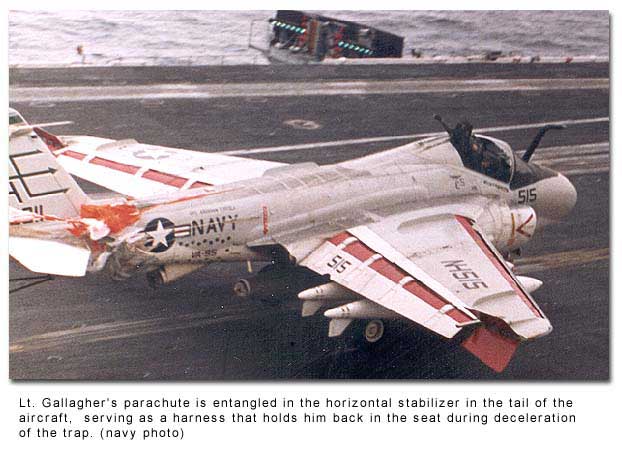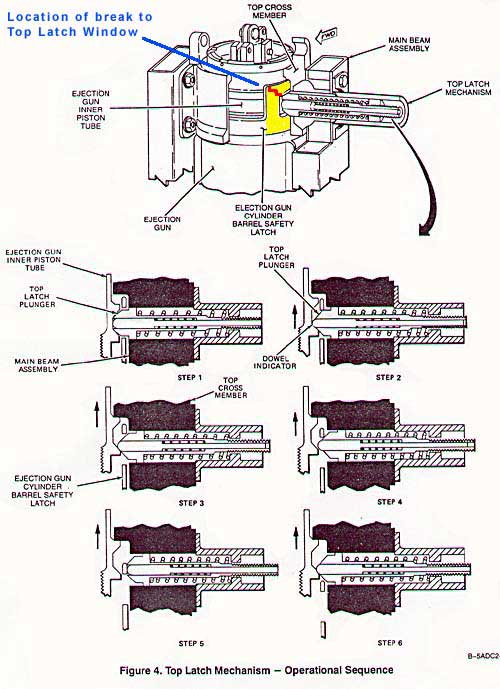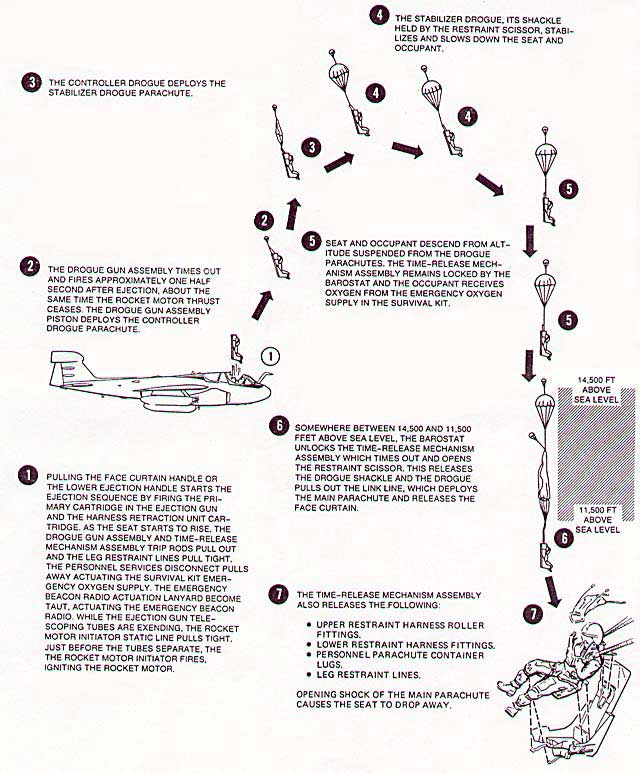|
back - - - > Keith Gallagher's A-6 Ejection Story 
Technical Aspects of LT Keith Gallagher's Mishap Summary Report from AME1 Paul M Jung, a Navy Safety and Survival Technician Kevin Coyne's Summary of Events Expert Commentary as to Cause of Crack to Top Latch Window <<< new Illustration - Top Latch Window Illustration - Ejection Sequence Summary Report from Paul M Jung, a Navy Safety and Survival Technician By AME1(AW) Paul M. Jung, USN The Martin-Baker Ejection Seat is manufactured by the Martin-Baker Aircraft Corporation in Higher Denham, England. The MarkGRU-7 used in the A-6E/KA-6D Intruder was retained in the aircraft by the "Top Latch Mechanism." The mechanism consists of a spring-loaded plunger, which extends from the seat between the two main structural beams of the seat. The plunger, when locked extends thru a window in a tab at the top of the ejection gun. The ejection gun is mounted to the cockpit structure. As a result of the design, the top latch plunger is the sole item that retains the seat in the aircraft. Normally locked by spring pressure, the firing of the ejection gun presses the plunger from the window, allowing the seat to depart the aircraft (See Top Latch Mechanism Illustration). *
* * * * * * * * * * * * * * * * * * * * * * *
In the case of LT Gallagher's seat, the window had cracked, presumably due to the repetitive stress of the combined aircrew/seat weight striking against it during negative 'G' maneuvers over the years. The "porpoising" maneuver in his particular mishap was the "straw that broke the camel's back." The top section of the window sheared away - the two breaks running from the upper corners of the window to the top corners. Half awake, I replied, "Mac, there's only successful and unsuccessful ejections." All he did was stare at me and flatly state, "Come on, you're gonna have to see this to believe it" Post-mishap inspection revealed a two key points - the one that stuck out most to me was that the gun was manufactured in 1963. It had been in service (and subjected to the negative-G stresses) for 28 years. So the question in my mind was "How many other seats are approaching the point of a similar failure?" The U.S. Navy had the same question, so every A-6E, KA-6D, EA-6B, and F-14A with similarly aged ejection guns were directed to be removed and X-rayed for similar defects. The results in our squadron alone were a little disturbing. We uncovered several other ejection guns with questionable top latch windows. Since that day, every GRU-7 style ejection seat that goes thru a scheduled inspection (every 224 days for the A-6E/EA-6B), must have it's ejection guns inspected by either eddy current or dye penetrant (eddy current being the preferred method), and any visual defects are grounds for immediate replacement. I personally have seen a number of guns fail this inspection over the last 9 years, but I never revisited an incident such as what LT Gallagher endured. So his harrowing experience has most likely saved another aviator from a similar (or worse) fate. AME1(AW) Jung At the time of this report (January 2001) Paul Jung was a Navy Safety and Survival Systems Technician attached to VAQ-134 (The "Garudas") at Naval Air Station Whidbey Island, WA. He was the VA-95's Aircrew Life Support Systems (ALSS) Quality Assurance Representative in 1991 at the time of Keith Gallagher's mishap
Based on the report above and LT Gallagher's account, I believe this is what occurred. 1. The Martin-Baker seat is held in the aircraft by a top latch mechanism, which is essentially a plunger forced into a 'V' shaped groove on the top of the catapult. It is inserted through a hole in a metal shield known as the 'Ejection Gun Cylinder Barrel Safety Latch'. This hole is known as the 'Top Latch Window'. Due to metal fatigue, the upper portion of the Top Latch Window broke off when exposed to the .5 negative G force from the pilot's pushover. The combined weight of the seat and man is nearly five hundred pounds, so this force was equivalent to about 250lbs against the top latch window. 2. When the top latch window broke, the seat rose far enough up under the negative Gs to pull the trip rod sears from both the drogue gun, and timer release mechanism. 3. Approximately 3/4 of a second later, after the drogue gun timer ran out, (recall LT. Gallagher's account that for a brief moment he felt his head touch the canopy followed by a loud bang) the drogue gun fired its slug through the plexiglass of the canopy, pulling out the drogue chute. This began the seat movement up the rails by air drag and put the BN's upper body into the air stream. The seat does not travel high enough to pull the cable that initiates the firing of the main rocket motor. 4. A second or so later, the TRM (time release mechanism) released the scissor shackle and the rest of the restraints on the seat as if seat separation was occurring. This allowed the drogue to extract the main parachute from its container and stream it out into the airflow. This in turn pulled the seat up to the position where it stuck due to the wind forces bending the catapult back slightly, and the harness from the chute holding Lt Gallagher in place as the chute wrapped around the tail of the aircraft. 5. Despite severe wind buffeting, the BN's attempts to pull the lower ejection handle, and the deceleration of the trap, the BN and ejection seat remain held in about the same position (tethered to the tail of the aircraft by his parachute and chute shoulder harness) until the pilot lands the aircraft on the deck of the Lincoln and the crash crew secure the ejection seat and lift the BN from the seat. Kevin Coyne For more information about ejections seats see Kevin Coyne's "The Ejection Site". Expert Commentary as to
Cause of Crack to Top Latch Window Alan Cody (aeronautical
engineer/escape systems) It would be interesting to hear Martin-Baker's side of this story. While prolonged and repeated negative g forces could theoretically induce metal fatigue within the ejection catapult latching assembly as described, I am skeptical that negative g's were the the contributing factor. The negative g forces required to cause structural failure of the catapult's top latch "window" would far exceed the dynamic force required to reposition/retract the top latch mechanism's locking plunger and "unlock" the seat from the catapult as the catapult's inner barrel initially extends/telescopes upward during ejection; thus, the seat should unlock far before structural failure. Since the Air Force never encountered this type of problem with its Phantoms which also flew high g profile missions and were equipped with similar Mk-7 seats, I'd suggest the Navy-wide problem could instead be a result of prolonged cycles of repeated high positive g's during carrier landings which would just as easily overstress the top latch assembly due to the majority of the seat and occupant's weight being located forward of the seat's vertical axis. During a carrier landing and hook arrestment, this weight is forced far forward of the seat's center of gravity which will force the top latch mechanism's locking plunger (which is bearing the entire weight of seat and crewmember) to move forward and upward within the catapult's top latch "window", thus creating identical stresses to those encountered during negative g's. Different cause-same effect. If the catapult was in fact
prone to structural failure as described, it would've easily been evident
during crash recovery of intact cockpits within which the catapult's subject
outer barrel remained after ejection. The 12-18 positive g's placed upon the
seat structure during the seat's initial vertical movement would surely have
similarly damaged the catapult had metal fatigue been present. Definitely an
interesting study! Glad Keith survived and that's what is most important! Tom Carter Alan Cody hit the nail on the head! In addition to the stresses of carrier landings, I'd also consider the 3 to 4 positive G's created during carrier catapult launches. It may not sound like much at first but it is a helluva lot of stress to place upon the top latch mechanism's locking plunger window which is only about one inch square and the stress would be compounded over time by the cycles of repeated launches/landings. As indicated by Mr. Cody, the Air Force did not encounter this problem with their Martin-Baker equipped Phantoms and that's simply because they did not perform high G carrier landings & launches. The argument of in-flight negative G forces holds little merit because the Air Force Phantoms (especially the G-model Wild Weasels) frequently performed extreme high G maneuvers as they ingressed and egressed their target areas. Additionally, both the Navy Blue Angels and Air Force Thunderbirds flew Phantoms for several years during which they too performed repeated extreme high G aerobatic maneuvers without any damage to seat catapults. I must note that the catapult damage could've just as easily been previously caused during maintenance if someone had attempted to use a crane to remove the seat from the cockpit without first unlocking the seat from the catapult (mistakes do happen). Catapults can be inadvertently
dropped during handling/transport (according to Air Force 11P-series
technical data, most egress system explosives can be dropped as much as 6
feet without being condemned for use). There are many potential causes that
should be closely examined before pointing to the negative G theory as the
root of the problem. Keith Gallagher Thank you all for the great comments. I enjoy reading them, and I check the log every day. I want to try to clarify some things surrounding the recent engineering discussions, and the force required to break the top latch window. I am not an engineer, and it has been a while since I thought about this specific aspect of the accident, so this will not be infinitely detailed. Martin Baker WAS involved in the accident investigation, and I never heard of them disputing any aspect of it (perhaps they did, but I never heard about it). There was also an engineering investigation into the reason behind the metal failure. My memory is this: the metal on the top latch window was already cracked, or even broken, on the seat before we did the slight negative "G." The seat did not rip through a solid piece of very strong metal, it merely completed the crack, and broke off a piece that was ready to break. The force required to do this was obviously significantly less than the force that would have been required to break an intact piece. This set off the chain reaction that is outlined on the other page. Why was it cracked? Was it cracked from some previous severe force on it, or did it just fatigue over time? I do not know if they ever came to a full agreement, but I think the prevailing thought was that it happened over time. The seat (and plane) had served longer than they had been designed to, and there was even a theory that the new catapults on the Nimitz class carriers put a different type/level of stress on the seat than had been previously seen. They immediately inspected all the seats of that type, and found several with cracks. They also added an inspection of the top latch window to the semi-annual seat inspection. If my memory is correct, I believe that they found over 15 seats with cracks over the next two years. I hope that helps to
clarify some of the questions. Thank you again for your comments,
discussion, and questions. Illustration - Top Latch
Mechanism
Illustration - Ejection
Sequence
This site published and maintained by Mark Gallagher. This is a non-commercial site. The purpose of the site is to share an interesting story. All rights are reserved on the content. The images, photos, sound clips, video and text of this site may not be duplicated on any web site or paper media for commercial purposes. You may save the HTML and images on your computer for display for educational, training or individual (non-commercial) purposes or print and make copies of the pages for same purpose. The best way to share this site with others is to e-mail, post or link to the web address of this site: http://www.gallagher.com/ejection_seat/ Publishing the text,
photos, images, sound clips and video from this site to any web site
available to the general public is not allowed without the permission of
Mark Gallagher and only non-commercial purposes will be considered. Last update: 2015 * * * * * * * * * * * * * * * * * * * * * * * * back - - - > Keith Gallagher's A-6 Ejection Story back - - - > gallagherstory.com
|

